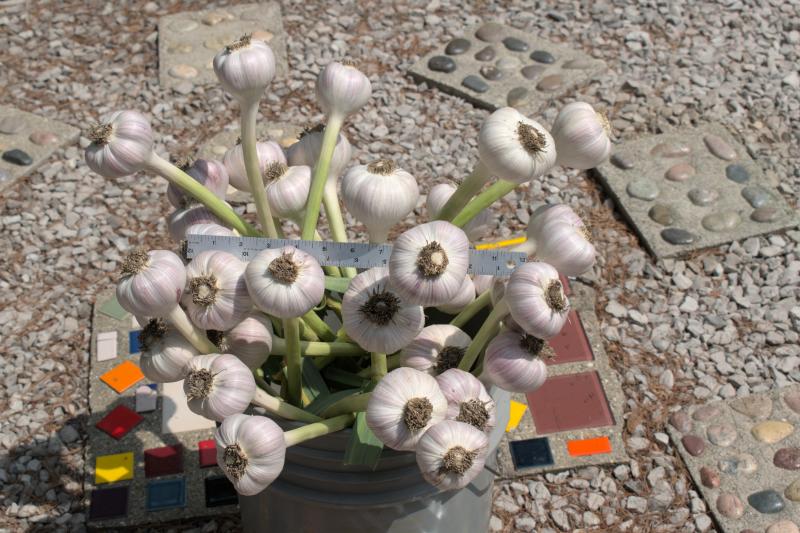Garlic
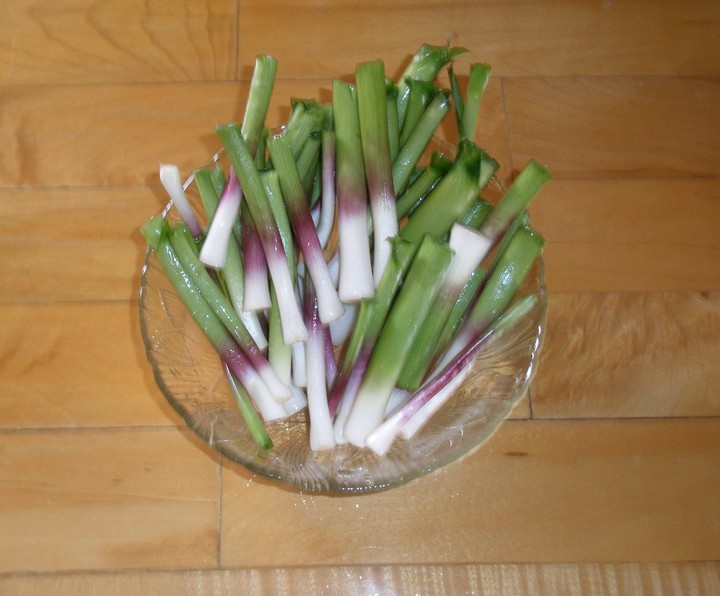 Green Garlic
Green Garlic
TABLE OF CONTENTS
- HARDNECK GARLIC
- HISTORY
- GROWING GENERAL INFORMATION
- SCAPES, CLOVES AND BULBS
- GREEN GARLIC
- PLANTING DISTANCE AND DEPTH
- CURING AND STORAGE
- UNUSUAL PLANTINGS
- 2021 HARVEST
- 2023 HARVEST
HARDNECK GARLIC:
I only grow one type of garlic, a hardneck garlic, this page includes the history as best I have determined and how to keep the garlic going strong.
A hardneck garlic is a garlic which forms a central stalk as it develops in the following spring and summer after it has been planted in the fall. The stalk will become hard as the plant dies back and dries out. The top of this stalk will form some small flowers and some small bulbs (called bulbules) and the tender green is called a scape - more on these below.
I will have some more pictures here eventually, but the above picture of green garlic is one I have handy as a starting point.
For those who are planting out of season check the last chapter for how to get those going and what to expect.
HISTORY:
I have grown this garlic myself since around 2004. For those from this area you may have known Josephine Manzoni. She was one of our local colorful people that you would see walking around town and she had no problem sharing her opinions. I always was glad to see her at the library. Of course after a while she learned that I was into gardening and mentioned she had some garlic that she had grown for quite a long time. A few days later she brought some by - a gift that has continued for these years and since she has passed away it is a plant which reminds me of her. I have passed it along to others as I get a chance.
She said that her uncle had given it to her when she was fairly young and that he had grown it for 40 years by that time. By the time she gave some to me it had been in this area around 100yrs.
It is a strong flavored hard neck garlic that is very well adapted to our local conditions (Mid-Michigan, USoA) and can probably survive harsher climates.
GROWING GENERAL INFORMATION:
The late summer and early fall is when I usually will plant garlic. Depending upon the weather you may see it start showing above ground before winter gets too cold. It looks like a green onion. If the weather is very cold and no snow cover the plants may get frozen back to ground level, this is ok, but you may also see the plants remain green if there is enough snow cover. When spring rolls around the next year the plants will continue growing until they finish.
This garlic has been pretty forgiving of our heavy clay soil as long as we raise the garden up to make sure there is enough drainage. A fertile garden soil with some organic matter will give larger bulbs, but in clay you do not need a huge addition of nitrogen to get a decent crop. Make sure to space the plants far enough apart so they get full sun without too much competition from weeds or each other. If planted too close together it is hard to get a stirrup hoe between the plants. When weeding you don’t really want to disturb the roots anyways so a quick scrape along the surface is good enough.
As the plant grows it will usually develop a central stalk (called a scape) with flowers and some small bulbs on top. The scape is edible as it develops (as are the small bulbs and flowers), but the bulbules can be grown to increase your garlic supply. When starting out this is a good way to increase the number of plants. Later on when you have enough bulbs growing you can snip these stalks off while they are still tender and eat them before they drop the bulbules on the ground. You may find out like me that you really don’t need to let them do that much before having too many garlic plants in places you’ll not be able to easily remove.
If the spring is too dry make sure it gets some water up until summer when the plant starts showing signs of dying back (the bottom leaves will start turning brown). When the plant starts finishing up you want to get it out of the ground before too long (within a week or two). If you leave it in the ground longer the tunic around the bulb will begin to break apart or get moldy - ideally you can get the bulbs out of the ground before that happens. Knock as much of the dirt off the roots as you can and leave the garlic to dry and cure out of the sun, but with air flow so it doesn’t start to get fungus on it. I use box tops/flats and turn the garlic a few times as it dries. If you haven’t cut off the stalks you can do that within a few weeks. I like the look when you leave a little bit of stem (an inch or two is enough). I trim the stem to preserve space when I’m harvesting and then if I am keeping some tiny bulbs from the scapes I will trim them off the other end at the same time (I don’t break them apart until after they are cured/dried).
SCAPES, CLOVES AND BULBS:
If you are like me there are some dishes that cannot be replicated without fresh garlic or garlic that has been properly cured and stored.
All parts of the garlic plant are edible, but I have to admit that I have not yet tried to eat any of the roots.
The scapes are very good eating while still tender and green when they are first forming.
As the plant grows and gets bigger the larger the plant the larger will be the bulb underneath the ground, but also the larger the scapes and bulbs up top will be. When the summer starts getting hot this signals the plant to get ready for dormancy and what happens is that the leaves start dying back and all of the energy from the leaves is transferred into the bulb under the ground (and any bulbules you’ve left up top).
Some people will trim off the scapes to make sure all the energy of the top of the plant is going to the bulb under the ground. In my years of growing I’ve found that the largest cloves, when planted, will give the largest bulbs no matter if I trim off the scapes or not. Since the scapes give me more bulbules to share around I let them finish up and plenty of them are quite large themselves and of course edible.
GREEN GARLIC:
Many people do not think of garlic as a green vegetable, but it is delicious and can be available from late winter into early summer. The only time you can’t really eat the garlic stem and bulb is when it begins to dry out too much and the tunic and stem become hard. Plant it extra deep to get more blanched white stem or more shallow if you want more green stem.
It cooks like a green onion and the more you cook it the less it will taste like garlic, but it is still good to eat. I have a hard time not eating it right in the garden when I’m harvesting.
Garlic -
May 16 2012 (1708K)
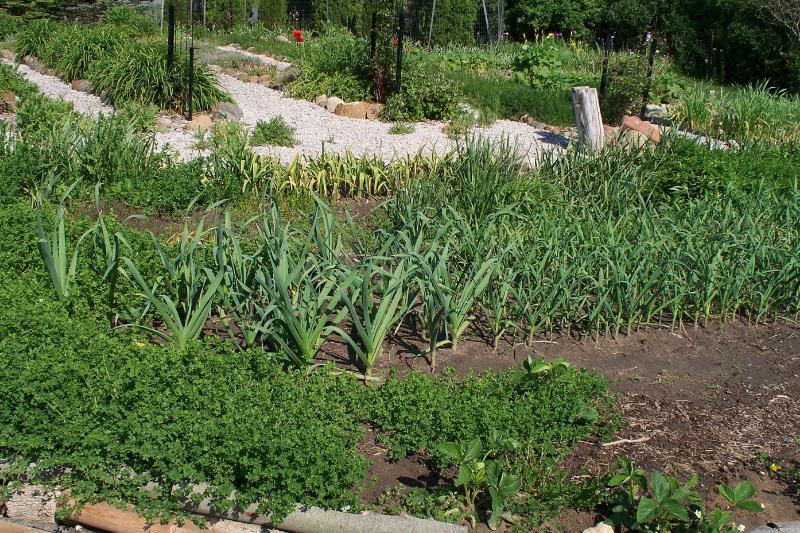
PLANTING DISTANCE AND DEPTH:
Always remember to save some of the largest cloves to replant and always select a variety of cloves from several bulbs instead of using only one bulb if you can help it. I’m always happy to share more with people if they lose their crop.
In the picture above you can see the larger plants to the left and the many green garlic plants to the right. I didn’t space them far enough to make it very easy to weed that year, but that was ok as I ate most of the small ones within a few weeks of when this picture was taken.
The larger the clove or scape the more space you will want to give it so it will grow to the largest sized bulb. 12cm (6 inches) is a good starting distance if you plan on lifting, curing, sorting and then replanting in the fall, but that is too close to weed easily between so I usually plant with more spacing so that I can get my stirrup hoe between the plants without damaging the plants. Having extra wiggle room makes it easier to avoid mistakes. For the other end of the size range of cloves I will plant 10-12 inches apart. For green garlic I will plant closer together to get more out of an area (but still leave space for the stirrup hoe).
Planting depth for most bulbs is three times the size of the bulb being planted. I don’t usually amend the garden soil too heavily for garlic because I am planting it in rotation with other garden veggies that get worm compost as a start so there is still plenty of nutrients for a second season or third season crop in that space. For planting green garlic which will be harvested sooner than regular garlic you want to plant it twice or more than the regular depth as this increases the blanched white stem, but if you like more of the green you can plant it the regular depth.
This is an example of both how large some of the cloves can get which I will use for planting. These cloves were leftover from planting so they were not prime sized or I didn’t need that many. Note however that besides the size of them being pretty large that they were also harvested the previous season and they’ve lasted in storage only being wrapped in a clean dry towel and kept away from the light or getting wet. So they’ve lasted almost a year after being harvested and while they’re not in perfect shape a fair amount of them are still edible.
Garlic Cloves -
Jun 13 2023 (4232K)
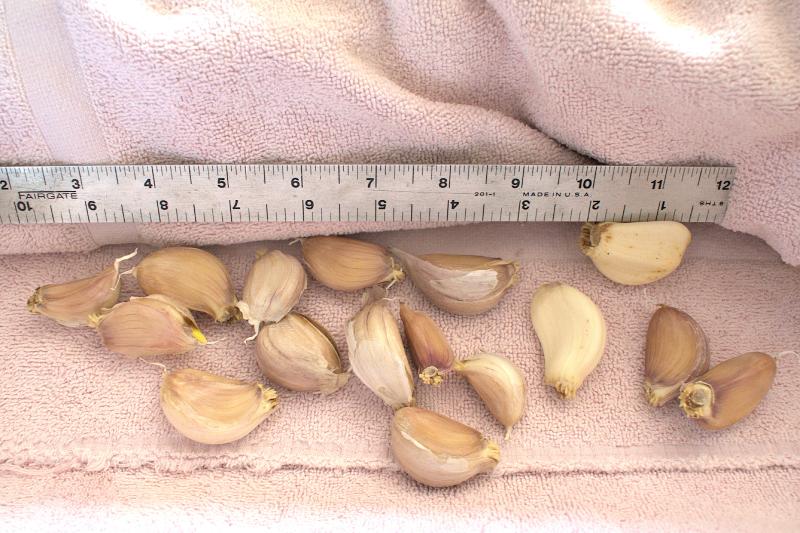
CURING AND STORAGE:
To cure garlic keep it out of the sun where it is warm and there is some air flow. You want the inside of the bulb (the tunics between the cloves) to be dry. I spread the bulbs out on cardboard flats for about a month inside the garage and I turn them once in a while to make sure there isn’t any fungus growing on the bottom side.
Once it is cured I store in a dark cool place that is dry. You should be able to keep it until later in the winter before it will start sprouting and putting some small roots out. Don’t worry, this is still edible (but hot if you bite into it). What I do with it if I am not going to use it within the next month or so is use a meat grinder (after I’ve peeled it and trimmed off the ends or bits of things that don’t look good) and drench it well with lemon juice and then freeze portions. It will then keep in the freezer for years like that or in the fridge for a few more weeks. Of course you can use other acidifiers like lime juice, orange juice or vinegars instead of lemon juice.
You do not ever want to store garlic in oil unless you are going to pressure can it first (I surely do not want to risk botulism poisoning).
Garlic -
Apr 5 2013 (1306K)
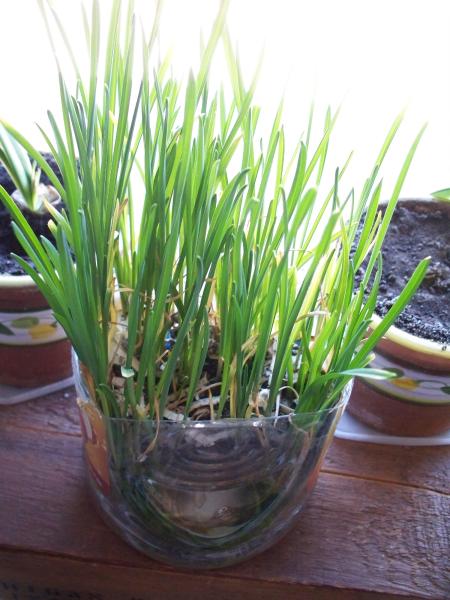
UNUSUAL PLANTINGS:
If you have picked up some garlic during the winter that you would like to grow for the coming year you can put it in a pot and then plant it out in the garden where you’d like it to be when the ground is thawed enough. If you got the bulbs from me that were already sprouting it doesn’t have to be really warm as this type of garlic is cold hardy, but you don’t want to put the plant from inside where it is very warm into freezing all at once, you would have to gradually acclimate it.
Full sun is always best for garlic with little competition from weeds or surrounding plants.
If you are starting from a small bulb or a very small clove you will not get a full sized bulb the first summer it grows. Many times you will only get a large single clove that doesn’t split into smaller pieces. I recommend that you just pick a spot you can grow it for the first and second season without having to lift it at all (mark the location so you know not to plant anything over it the following spring :) ) - space them at least 20cm (or 8 inches) apart - it is much easier to do a quick scrape with a stirrup hoe if there is room between the plants.
If you do have to lift it, let it dry well out of the sun and replant it the next fall (normal bulb planting depths are three lengths the size of the bulb being planted). If you have very good conditions you will get a medium sized bulb the second summer. For the full size you can expect from this garlic you may have to grow it again another year. I can get thumb sized cloves from this variety. For the next fall’s plantings always select the largest cloves or bulbules and give them enough room (for the largest cloves I will space them even more than the 20cm above).
If you want to increase your garlic supply these hard necked garlic plants will provide both scapes up top of the stalk and the bulb below so you would not want to snip off the scapes when they start to show up. It does make a small difference in the size of the bulb to remove the scapes (and eat them :) ) but I now usually only do it for patches of garlic that I am trying to remove because they have spread and I don’t want them to go any further.
Try to avoid planting it in the same place for a long time to keep diseases and bugs from being a problem, but as of yet even in fairly heavy clay soil the garlic will keep coming back year after year even if you don’t lift it. The bulbs in such a clump may not get very big after a few seasons if they are crowded together, but it is still edible. I am trying to clear it out of a few places and so I will dig it up in the spring and eat it as a green garlic.
The picture above is of bulbules that were planted in a pot and then let grow to be used as garlic chives. After a few seasons of growing this garlic you will likely have way more bulbules than you can use or give away so this is another way to use them. Like many bulb plants you can keep trimming the greens off until they give up growing any more. This does use the energy up from the bulb so it will not usually grow as big the next time it does come up.
The picture below is of a scape growing another scape - nature does some fun things!
Strange Garlic Scape -
Jul 21 2013 (778K)
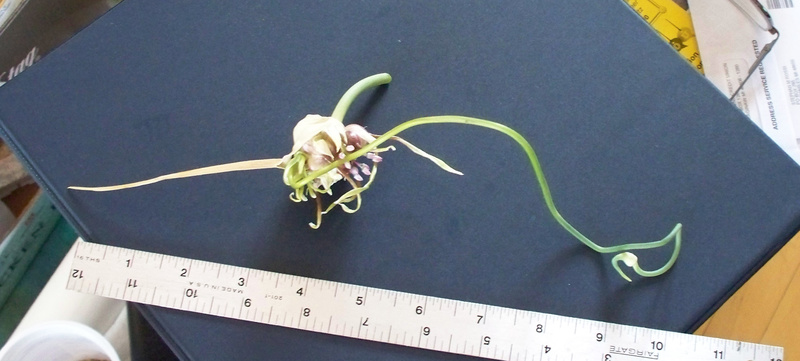
2021 HARVEST:
The garlic spent some thyme drying. Yes a bit of a pun but also the true context as that edge where they are all lined up drying is creeping thyme. The garlic was not left out in the harsh sun it was a cloudy and not so hot day so that really helped let that dry off after it was lifted and cleaned off a bit (pulled off the outer tunics and dried leaves so they could all get buried). What I did not plan for was how that worked out to make picking up those large garlic bulbs later in the day when some raindrops started falling. Having them reachable from the gravel a bit down made picking them up and putting them in buckets go really quick.
Garlic Drying -
Jul 20 2021 (3775K)
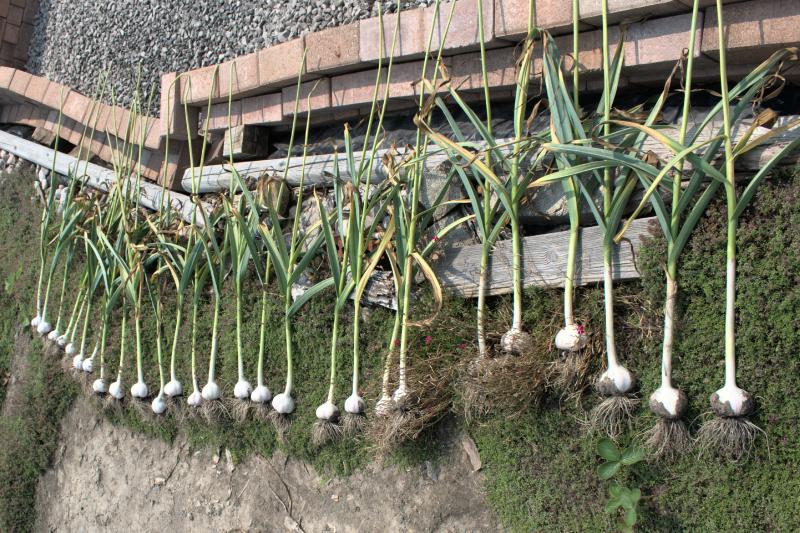
The smaller bulbs and rejects or garlic were not as organized as the main crop. Most of these were from the green garlic patch that was planted next to the main crop of larger cloves. They were planted deeper and using smaller cloves. A few of the main crop bulbs also had some issues that I didn’t want them grouped with the main crop bulbs.
Smaller Garlic -
Jul 20 2021 (3911K)

Some people think that the old ways of doing things are best. Measuring up.
Not Quite A Foot -
Jul 20 2021 (3830K)
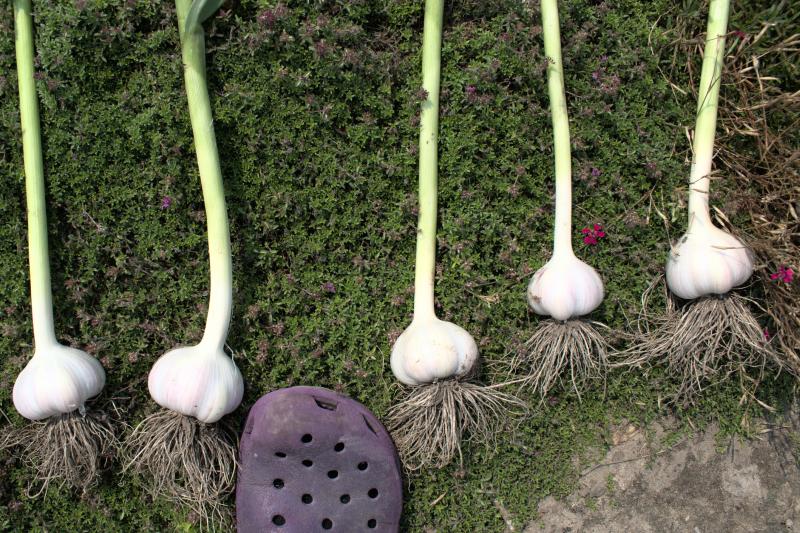
A more modern approaches to measuring, but of course notice that I grabbed the inches measure and not the centimeters… So not as modern as it should have been. The results were smaller than normal but considering the long dry spell we had they came out ok.
Higher Tech -
Jul 20 2021 (3025K)
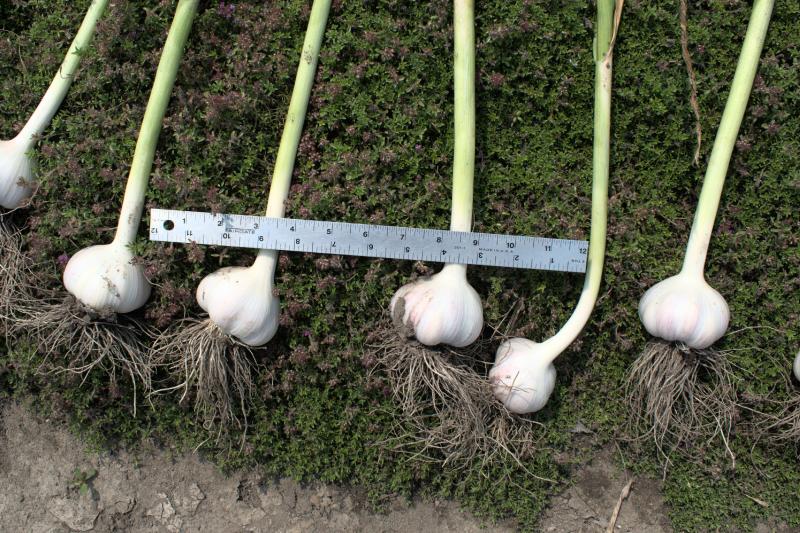
2023 HARVEST:
Regular watering was required during a long dry spell in the early summer of 2023, but in the end the harvest was worth it.
Garlic Harvest -
Jul 23 2023 (4057K)
